Marijuana ended up being a Schedule I substance when the Controlled Substances Act (CSA) passed Congress in 1970. Lawmakers who knew that cannabis was safe and was widely used as a medicine proposed creating a commission to conduct an in-depth study to “aid in determining the appropriate disposition of this question in the future”.
President Richard Nixon appointed Republican Pennsylvania Governor, Raymond P. Shafer, a former prosecutor with a “law-and-order” reputation to run the commission. Nixon also hand-picked eight other members while the Congressional Leadership appointed another four Senators and Members of Congress to form a 13 member commission, that became known as the ’Shafer Commission’.
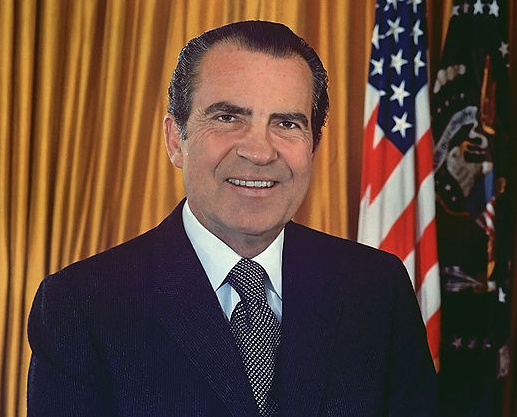
The Shafer Commission had 76 team members on the payroll and it recorded thousands of pages of transcripts from formal and informal hearings. Commissioned a number of reports and papers, published in four volumes on more than 3700 pages.
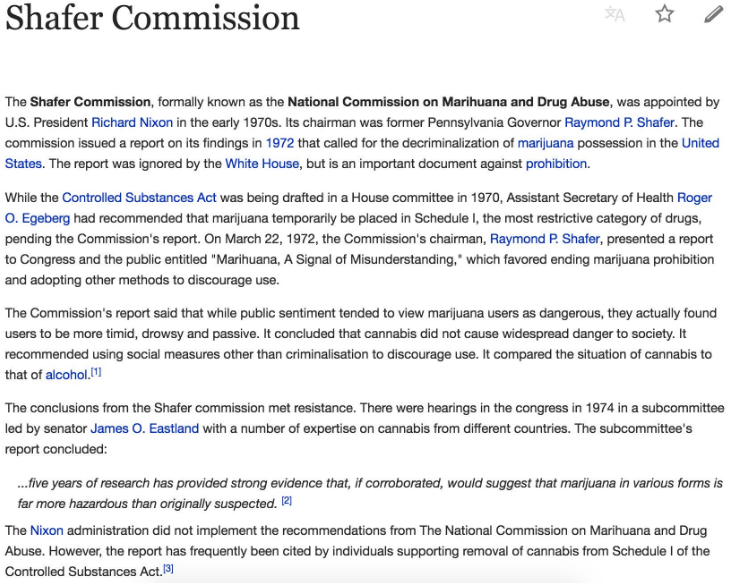 Source: https://twitter.com/MassRoots/status/763842514717597696
Source: https://twitter.com/MassRoots/status/763842514717597696
While everyone would expect such a commission to be left alone to do its job and conclude its recommendations based on facts and science, as ‘the oval office tapes’, de-classified in 2002 revealed, Nixon made it clear from the beginning that he wanted the report to ‘support’ his ideology and ‘tough on crime’ policies and he wanted a report that would blur the distinction between marijuana and hard drugs.
The tape recordings reveal that just as the commission was beginning its investigation in May 1971, Nixon told his aide H.R. Haldeman, “I want a goddamn strong statement about marijuana. Can I get that out of this sonofa-bitching, uh, domestic council? I mean one on marijuana that just tears the ass out of them.”
Two weeks after making this statement, Nixon was going through his news clippings summary when he said to Haldeman, “Every one of the bastards that are out for legalizing marijuana is Jewish. What the Christ is the matter with the Jews, Bob, what is the matter with them? I suppose it’s because most of them are psychiatrists, you know, there’s so many, all the greatest psychiatrists are Jewish. By god, we are going to hit the marijuana thing, and I want to hit it right square in the puss. I want to find a way of putting more on that.”
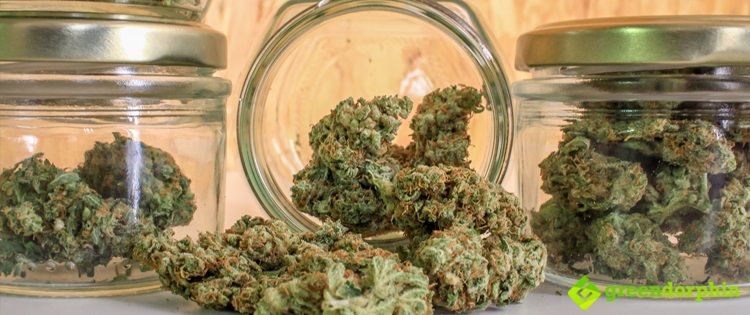
Shafer was under a lot of pressure to give in to the wish of the president over the best interest of the American people.
In a meeting with Shafer on 9 September 1971, Nixon told Shafer “I think there’s a need to come out with a report that is totally oblivious to some obvious differences between marijuana and other drugs, other dangerous drugs… And also that you don’t go into the matter of penalties and that sort of thing, as to whether there should be uniformity in penalties, whether in courts, I’d much rather have uniformity than diversity…
You’re enough of a pro to know that for you to come out with something that would run counter to what the Congress feels and what the country feels and what we’re planning to do would make your commission just look bad as hell… Keep your commission in line.”
Nixon’s aide, Haldeman noted in his diary, “[Nixon] emphasized that you have to face the fact that the whole problem is really the blacks. The key is to devise a system that recognizes this while not appearing to.”

Despite the constant pressure to give in and bend the outcomes, Governor Shafer delivered an honest, facts based report, with conclusions based on all the evidence the Commission collected and examined. Shafer prioritized the truth and the interest of the American people even though he was being considered for a federal judgeship at the time and opposing the clearly corrupt demands of the president did not help his ambitions to become a federal judge.
Nixon saw a strong connection between civil rights advocates, anti-war demonstrators and marijuana users, despite the Shafer Commission pointing out the fact that people with all type of backgrounds used cannabis.
Despite the scientific factual evidence compiled by the Shafer Commission, Nixon stuck with his uneducated ideology and embarrassed himself with statements that demonstrated his complete lack of understanding of the matter as well as his willingness to break the law to get his way.
A heavy drinker himself, Nixon promoted alcohol over cannabis, not knowing the real dangers of alcohol that kills millions of people every year, in contrast to cannabis, that has never killed anyone.
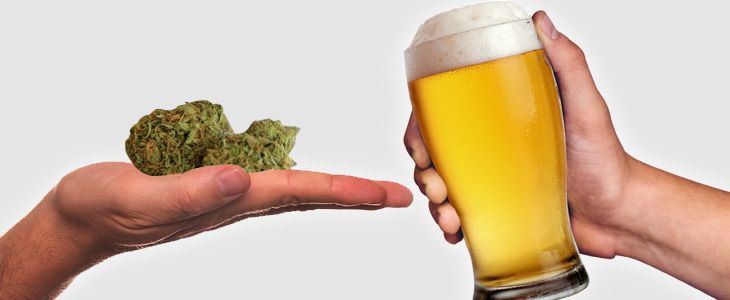
He falsely claimed that marijuana is smoked “to get high” while “a person drinks to have fun.”
“At least with liquor I don’t lose motivation.” he said. Oh boy, you surely do lose your motivation and a lot more with alcohol and Nixon is a good example of just that.
Nixon thought that marijuana use would lead to the downfall of the US, while drinking makes countries stronger, naming Russia, England and Ireland as examples.
The president not only was deeply misinformed and uneducated about cannabis, he was similarly homophobic and perhaps a bit too drunk.
“You see, homosexuality, dope, immorality in general. These are the enemies of strong societies. That’s why the Communists and the left-wingers are pushing the stuff, they’re trying to destroy us.”

Mr Shafer ignored the president’s corrupt attempts to intimidate the Commission and published the true findings.
The most important recommendation of the Commission was the decriminalization of possession and non-profit transfer of marijuana.
The Commission recommended no punishment – criminal or civil – under state or federal law.
Other notable conclusions of the report were:
– No significant physical, biochemical, or mental abnormalities could be attributed solely to their marihuana smoking.
– Most users, young and old, demonstrate an average or above-average degree of social functioning, academic achievement, and job performance.
– No valid stereotype of a marihuana user or non-user can be drawn.
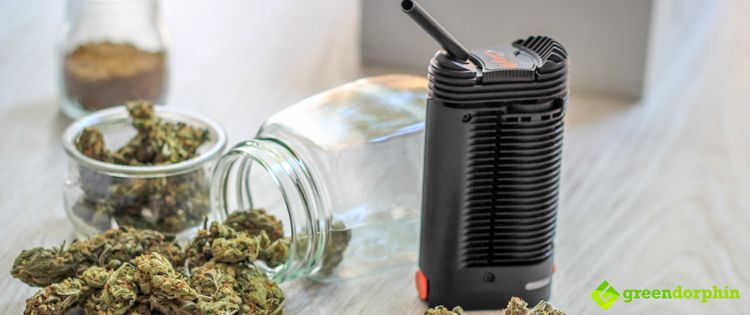
– Neither the marihuana user nor the drug itself can be said to constitute a danger to public safety.
– Young people who choose to experiment with marihuana are fundamentally the same people, socially and psychologically, as those who use alcohol and tobacco.
– Recent research has not yet proven that marihuana use significantly impairs driving ability or performance.
– No verification is found of a causal relationship between marihuana use and subsequent heroin use.
– Most users, young and old, demonstrate an average or above-average degree of social functioning, academic achievement, and job performance
– Marihuana’s relative potential for harm to the vast majority of individual users and its actual impact on society does not justify a social policy designed to seek out and firmly punish those who use it.
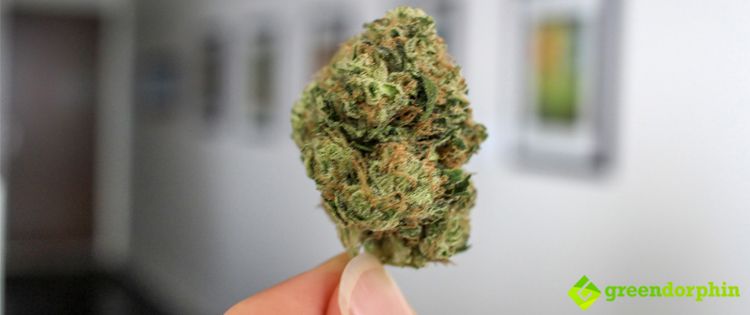
– In sum, the weight of the evidence is that marihuana does not cause violent or aggressive behavior; if anything marihuana serves to inhibit the expression of such behavior.
With the Share Commission concluding a science-based positive recommendation, the rescheduling that the Commission was assembled for was swept under the carpet.
In 1973, Shafer wrote the foreword for the reprint of the “The Marijuana Problem in the City of New York”. In this forward, Shafer acknowledged that his Commission came to a similar conclusion than the Guardia Committee Report nearly 20 years earlier.
“Much of the substance of the Laguardia Committee Report has been recently confirmed … despite the limitations under which the LaGuardia Committee worked and the advantages under which the National Commission operated, both sets of findings are strikingly similar in the three areas that have historically created public apprehension about marihuana use, namely that marihuana, in itself, is physically addictive, produces insanity, and leads to crime. Both reports dispelled such allegations and myths.”
“Although the Commission’s report, like the LaGuardia Committee Report, has been subject to criticism, it is unlikely that its findings or recommendations will suffer the fate of the latter —to wait almost 30 years before the public is ready to accept or at least debate dispassionately the issues raised… Whereas the LaGuardia Committee examined a phenomenon fairly restricted in social grouping and geographical limitation, such is not the case in 1973. With almost 250,000 persons arrested yearly in this country for marihuana offences, coming from all walks of life, the majority being under the age of 25, the preponderance never having been arrested for any other criminal activity, the mix and the problems have dramatically shifted focus. The social nervous system is feeling the pressure, and the collective brain and conscience are demanding relief.”
A year after Nixon’s “all out war” marijuana arrests jumped over 100,000 to 420,700 people. Since the Commission recommended marijuana offences not be a crime over 20 million people have been arrested.
Share your views in the comments section below.
- How to Use Waxmaid Honey Pen? - April 9, 2024
- How To Choose The Best Electric Dab Rig For Christmas - December 7, 2023
- Maintenance Matters: Keeping Your Glass Water Bong in Pristine Condition - October 9, 2023


